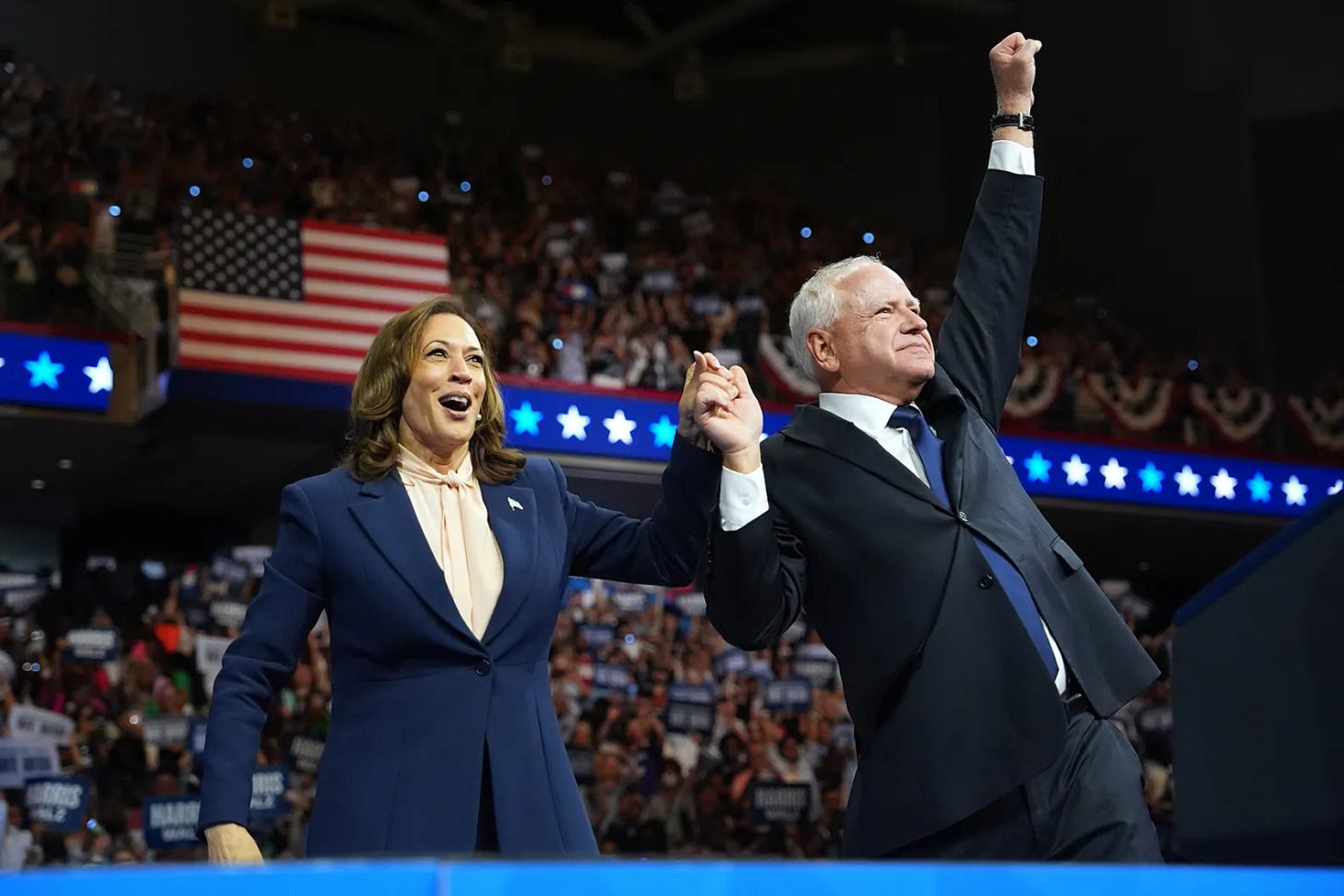Tim Walz: The Safe Choice
But is the safe choice the best choice?
Earlier this week, Vice President Kamala Harris announced her running mate for the 2024 election: Tim Walz.
Walz, the sitting Governor of Minnesota, hit the ground running in his bid for the position after his viral interview on MSNBC’s Morning Joe, where he referred to Republicans as “just weird.” This narrative exploded within the Democratic Party, with Harris herself and other contenders for the VP pick such as Pennsylvania Governor Josh Shapiro and Kentucky Governor Andy Beshear latching onto it basically overnight.
This, coupled with his extremely decorated background as an Army National Guard veteran, schoolteacher, football coach, and member of the U.S. House of Representatives, makes Harris’s choice seem like a no-brainer - at least at first glance.
It’s Unclear if Walz Brings Any Advantages
In terms of being a Vice Presidential nominee, Walz’s strength comes not just from his background or his contributions to the Democratic Party, but due to the fact that he is a relatively uncontroversial candidate. The “Golden Rule” of VP picks, so to speak, is to “do no harm,” meaning that the choice should only improve the ticket’s chances of winning, not hurt it. This can be accomplished in one of two of ways: 1) by bringing certain demographics into your coalition; or 2) getting the electoral edge in key swing states.
Despite Walz’s lack of controversy, however, he doesn’t seem to bring much else to the table.
For starters, Walz isn’t showing any meaningful gains with the demographics that the Harris campaign needs: blue-collar workers and small-town residents. NBC’s Steve Kornacki highlighted this problem, emphasizing that, of the 49 “Trump surge” counties in Minnesota, Walz won the same amount as President Biden did in 2020: one. This lack of improvement is problematic given that these counties are demographically similar to large portions of Wisconsin, Michigan, and Pennsylvania - the swing states that everyone is eyeing this election.
Harry Enten, CNN’s Senior Political Data Reporter, also touched upon Walz’s shortcomings by pointing out that a Republican candidate hasn’t won in Minnesota since 1972, and that there were no signs of that streak being broken. Since Minnesota isn’t necessarily a make or break state for the Democrats, Walz’s selection doesn’t really give an advantage in the Electoral College.
It’s also worth noting that, even though Walz was a popular pick among left-leaning voters that cast their ballots as “uncommitted” during the Democratic primaries, they still voiced their dissatisfaction even after he was chosen and Harris had met with them to hear their concerns. In other words, if Walz was chosen to appease this voting bloc, it would seem to have been ineffecitve.
There May Have Been Better Picks
Given that Walz has neither brought new demographics under the Democratic Party’s tent, nor raises the chances of winning in a narrowly-decided state, the mere fact that he “does no harm” begins to look more like a missed opportunity.
Josh Shapiro, the sitting Governor of Pennsylvania and the candidate that was considered the front-runner throughout most of Harris’s VP selection process, might have been a better fit for the position since he is widely popular within his state (61% approval). Additionally, there is evidence suggesting that VP picks tend to gain campaigns anywhere from 1 to 2 points within their home states. In an election where outcomes are determined along the margins, the lack of this advantage in Pennsylvania - the most important swing state of them all - could prove fatal for Harris’s campaign.
The Governor of Kentucky, Andy Beshear, also might have been a superior pick to Walz. As an even more popular Democrat than Shapiro (at 65% approval) in a solid Republican state, Beshear offered the prospect of winning over independents and moderates not just within the Midwestern swing states, but also in other Southern states like Georgia. This isn’t an impossibility, especially given that the Cook Political Report just rated Georgia as a “toss up” today, and with recent polls showing Kamala Harris being virtually tied with Donald Trump in the state.
Walz Isn’t a Bad Choice
Even if Walz is a safe pick, that doesn’t necessarily mean he’s a bad one. After all, it’s not like either Shapiro or Beshear were without their shortcomings, with Shapiro being marred by his pro-Israel stance on the war in Gaza and the controversy of a sexual harassment case within his staff; and the chance that Beshear’s potential is overestimated given that his father, Steve Beshear, was also a popular Governor in the state.
Tim Walz is a fine pick. His track record of popular policies, such as providing free college tuition for low-income students and free meals for schoolchildren, is difficult for his opponents to argue against. He also has the Midwestern charm that makes him feel authentic and likable (shown in his 55% approval rating), meaning it’s entirely possible for him to gain traction within Minnesota’s neighboring swing states - something that Trump’s VP pick, J.D. Vance, is struggling with.
The only reason that Tim Walz is under any form of scrutiny at all isn’t for his background, his policies, or his character - all of which are perfectly fine. Instead, it’s for wondering the efficacy of his pick. In such a consequential and close election, is the safe choice enough to get the Democrats over the finish line in November?



